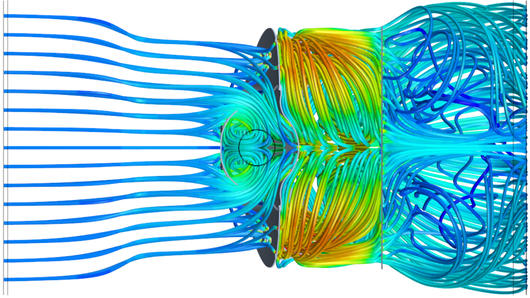High-Performance Computing Center Stuttgart

When designing an emissions reduction system for a new vehicle, one of the most important tasks that Purem by Eberspächer engineers undertake is to optimize the design of the unit within which urea–water solution mixes with exhaust gas. A trial and error design process in the laboratory would be completely impractical, and this work is only possible by running computationally demanding computational fluid dynamics (CFD) simulations.
Purem by Eberspächer has a computing cluster in-house. However, the computing power required for CFD methods is enormously high. For many years, the company’s engineers have thus used the supercomputer of the High-Performance Computing Center Stuttgart (HLRS) for such simulations. According to Dr. Laurence Marie-Hieber, head of the Fluid Dynamics and Emissions Group at Purem by Eberspächer, HLRS’s Hawk system has become an indispensable tool in the company’s product design workflows. “It’s hard to imagine anymore how we could ever do our work without HLRS,” she says.
With an academic background in aeronautics, Marie-Hieber leads a team that develops CFD methods and tools, which project engineers at Purem by Eberspächer use when designing exhaust systems for new vehicles. Because the company receives projects from numerous manufacturers and works on many different vehicles, its exhaust systems must always be designed based on the manufacturers’ specifications — for example, with respect to the engine being used and the space available for the exhaust system. The mixing module is thus not a standard component, but requires customized solutions that consistently remove NOx from exhaust in a homogenous and efficient manner.
As designs are being prepared, Purem by Eberspächer engineers run CFD software on HLRS’s high-performance computing (HPC) system that enables them to accurately predict how the exhaust gas and the urea–water solution droplets will interact in the confined space of the mixing module. The reactions take place in a turbulent flow, contained within a very small space at high pressure. Such two-phase simulations are very computationally demanding, and when so-called transient simulations are required — modeling how behavior in the system changes over time — this work becomes far too time consuming for conventional computing clusters. Getting an accurate model is important for being sure that the shape of the mixing unit facilitates consistent and effective reactivity.
In addition to optimizing the chemical reactions between the liquid and gas, Purem by Eberspächer engineers must also ensure that urea deposits will not accumulate as residues on the mixing unit’s walls. “We absolutely need to avoid this, because the accumulation of residues tells us that the urea–water solution is not properly evaporated and is not mixing properly with the exhaust gases. This means that not as much nitrogen oxides are being converted as necessary,” Marie-Hieber explains.
Purem by Eberspächer uses HPC in an iterative process that involves both simulation and laboratory experiments. The process begins with a simulation that guides the production of a prototype, which is then tested in the laboratory. During experiments, technicians take measurements to assess the mixture quality, and to determine where deposits develop. Their findings are then fed back into the simulation, enabling the computational engineers to make suggestions for potential optimization.
During optimization, the engineers don’t run just one computationally demanding simulation, but up to 10 design variants on Hawk in order to zero in on the best possible design. Because differences in temperature, pressure, the amount of urea–water solution being used, and exhaust gas velocities can also affect the conversion rate of the NOx-eliminating chemical reactions, they also test the most promising designs under various operating conditions. “Using Hawk we get our results very quickly, and of course that is a huge advantage,” Marie-Hieber remarks. “It enables us to rapidly eliminate certain geometries and variants.”
During her career, Marie-Hieber has seen the growth of high-performance computing open up new opportunities in automotive engineering. “As computing performance grows you begin to notice what else can be simulated,” she says. A condenser, for example, consists of many parallel channels, and in the past, she explains, one would have simulated one channel at a time. This meant making assumptions and scaling up the results to approximate how the entire device might function. Today it is possible to simulate the entire condenser at once, providing a much more realistic model of the entire system. “This is important, because when you make assumptions you become more distant from reality,” she points out.
Purem by Eberspächer — like all companies in the mobility sector — is in the midst of a transformation process toward solutions for more climate-friendly, sustainable alternatives such as hydrogen and fuel cell applications. Here, too, simulation using HLRS’s supercomputer is helping in the company’s research and development activities.
Eberspächer is not only active in Germany, but is a global supplier of parts and solutions for automakers across the world. According to Marie-Hieber, the supercomputer at HLRS could also enable the company to support engineers in its international offices. “What we would really like to be able to do is to enable our colleagues in our international offices to also do their computing at HLRS, because our experience in Germany has been so positive,” she says. Although she acknowledges that many details of such an arrangement need to be discussed further before it becomes possible, it is clear that Purem by Eberspächer’s use of HLRS’s computing resources will continue to be important to the company’s ability to deliver high-quality, precision products for the transportation of the future.
— Christopher Williams